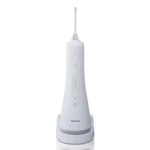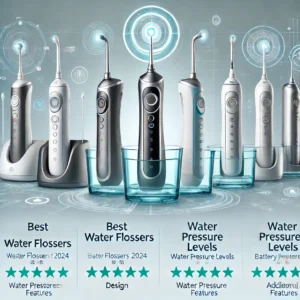Improve your oral health
Did you know that it is scientifically proven that the use of a dental irrigator improves oral health ? Learn on our website everything you need to know about irrigators and oral hygiene.
What will you find in Smile Savvy?
Browse our categories, in which we offer you verified and current information on oral health:
What is a dental irrigator?
A dental irrigator, or oral irrigator, is a home device that emits a jet of water that passes between the teeth and gums, removing any food, plaque, or bacteria.
Some models of dental irrigators come with different nozzles and adjustable pressure levels, allowing you to customize the cleaning experience according to the needs and sensitivity of each user.
Advantages of using it
- It guarantees a deeper cleaning, improving the health of teeth and gums.
- Helps reduce tartar and prevent oral diseases.
- It can be especially useful for people with braces or implants, making it easier to clean difficult areas.
- It promotes circulation in the gums, strengthening them and helping to keep them healthy.
- Contributes to the prevention of dental stains, maintaining a more attractive dental aesthetic.
According to recent studies, regular use of an oral irrigator can contribute to the prevention of diseases such as gingivitis and periodontitis, promoting healthier and stronger gums.
Tips for taking care of your oral hygiene
We offer you tips for taking care of your oral hygiene, with special emphasis on everything a dental irrigator can do for you.

How to use a dental irrigator to reduce bleeding gums

Is it good to rinse with water after brushing your teeth?

What to eat when you get a tooth pulled

Is it good to use mouthwash?

What is it for and how is baking soda used in mouthwash?

Solutions to bruxism, my personal experience

What you should know before buying a dental irrigator

5 dental habits that I avoid and that you should avoid too

What to eat with Braces
Dental Irrigator Reviews
Here you’ll find detailed reviews, expert ratings and user reviews, all to help you choose the perfect irrigator to fit your oral health needs.
Guides and tutorials
Ideal for both beginners and advanced users, these step-by-step guides will help you improve your oral health in a practical and simple way.
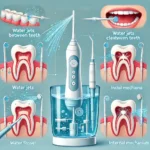
How the water flosser works

Where to buy the Waterpik Dental Irrigator
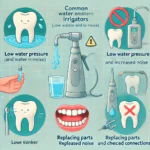
How to fix a water flosser that doesn’t work

Which oral irrigator should I buy?

How to clean the dental irrigator
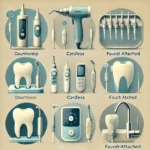
Types of dental irrigators
What types of irrigators exist?
To cover different needs, manufacturers have created three main types of irrigators: desktop (powerful), wireless (more comfortable to use), and travel (light).
Desktop
They are distinguished by their stationary design and greater water tank capacity. They offer multiple pressure settings and interchangeable nozzles. Their size and characteristics make them ideal for intensive and personalized use at home.
Travel
Their compact and lightweight design makes them easy to transport. They are often battery powered and have smaller water tanks, suitable for temporary use away from home. Although they may have fewer pressure settings, their convenience and adaptability make them essential for frequent travelers.
Wireless
They do not need to be connected to the electrical network, which makes them more versatile and convenient to use. They work with rechargeable batteries, and their design is usually more compact and ergonomic, allowing easy handling. Although they may have a smaller water tank, their freedom of movement makes them ideal for modern and efficient oral hygiene.
Comparisons of irrigators
Make informed decisions with our comparisons of dental irrigators. Get to know the opinions of dentists and users, learn about the best brands and models, and discover which one best suits your needs.
Dental health news
Updated information on technological advances, recent studies, and trends in oral care.
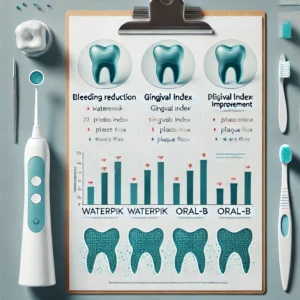
New advances in reducing gingival inflammation and dental plaque
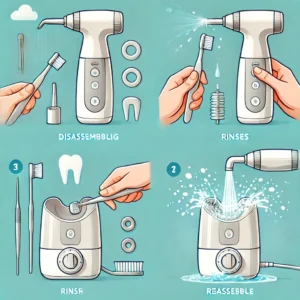
Your Irrigator could fill with Bacteria if you don’t do this

Edentulism and mouth cancer: prevalence and consequences

Innovations in toothpaste and its impact on oral health
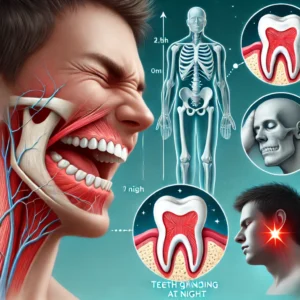
Is bruxism associated with changes in neural pathways?
Solve all your doubts
These are some of the most common questions about dental irrigators. Below, you can click on ‘See more’ to access the list of frequently asked questions articles.
The most important thing is to lean over the sink before you start to spray the water onto your teeth. We have put together a step-by-step User Guide that will help you through the process.
Pay attention to the power, the number of replaceable nozzles, the battery life (if it is a travel model), the amount of water the tank can hold, and the reviews from other buyers. Here you can read the criteria to consider when buying an oral irrigator.
It is recommended to use it after each meal to ensure that any residue and dirt that might remain on the teeth are removed.
It can help remove small stains caused by food, aiding in whitening. But keep in mind that it cannot remove coffee stains or those caused by tobacco. It will reduce them, but it won’t make them disappear.
Choose one that does not have too much power, as a too-powerful jet could weaken the filling. For use with implants, we recommend a model specifically designed for that purpose.
When buying an oral irrigator, do not think about the number of accessories it comes with, but about the use you will give it. The more accessories it has, the higher its price will be.
The only existing alternative is to go to the dentist, so they can use a professional oral irrigator. You will achieve a deeper cleaning, but it will cost you more.
The biggest risk is believing that it can be used as the only cleaning tool. If we forego brushing, we will be engaging in incorrect oral hygiene, as dental irrigators should be used as a complement to other cleaning methods. If you are interested in knowing the contraindications it might have, follow the link.






